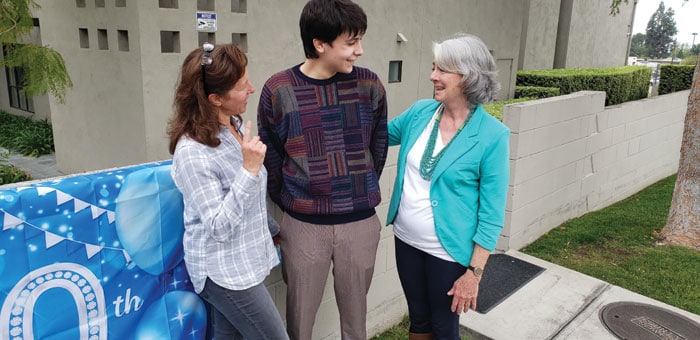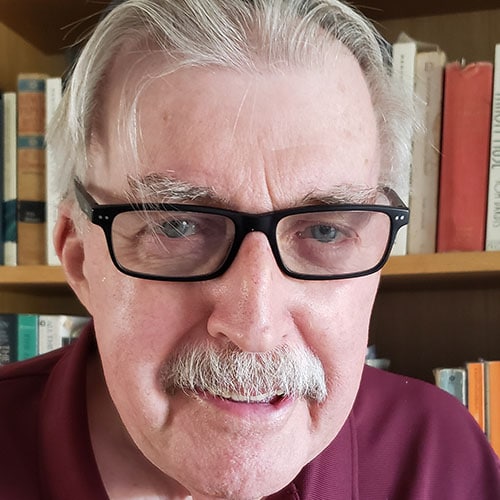 President Stacey Sharp, left, Sam Svonkin, Betsy Kahn. Photo by Ari L. Noonan.
President Stacey Sharp, left, Sam Svonkin, Betsy Kahn. Photo by Ari L. Noonan. When a synagogue with one of the oldest histories in the Los Angeles area celebrated its 100th birthday this month, the emphasis was on youth. The Pasadena Jewish Temple and Center (PJTC)is planning for a future at least as lengthy as its past.
Executive Director Beryl Strauss said that when she started at PJTC in 2016, 60% of congregants were over 65, including the No. 1 senior, Mollie Wolzeck, who is 97 years old.
Thanks to a renewed interest in youth groups and a campaign to attract young families, the reverse is true. Among the 500 families at the Conservative synagogue, two-thirds of the members are on the younger side.
Strauss said the environment changed when the temple expanded its professional staff and Youth Director Melissa Levy moved into a newly created position, Director of Congregational Engagement.
“Melissa had started a wonderful youth program. And now, with a new position, she has infused our community with a new passion.”
Temple member and chapter president of United Synagogue Youth Sam Svonkin, 15, had been busy in the runup to PJTC’s April 3rd centennial celebration, helping to set up a pop-up history museum
“I was interested in the centennial project and in learning more about PJTC’s history,” he said.
When Betsy Kahn, a retired school librarian who joined PJTC seven years ago heard about the centennial, she knew she wanted to get involved.
“I had not had any involvement with kids [since retiring], and I missed it,” said Kahn, a member of the musical group that sings and plays on Shabbat mornings. “That had been my whole life as a school librarian.”
Looking at the students’ dedication to PJTC and its past, Kahn said, “These kids are all self-selected. We asked who would be interested in researching the history of our synagogue. To have a dedicated group of kids interested in history is unusual. This is a lovely product,” she continued, “but for me, the real success was in the process. We literally dug dusty boxes out of closets. We were trying to make connections and figure things out.”
Since last fall, Kahn and students have been assembling the backbone of the museum, the PJTC’s 10-decade history. She has also organized the commemorative book’s content, and has been commissioned to research the history of the Sisterhood, the Men’s Club and its Religious School.
“Especially after being involved in research for this project, as a librarian-type and historian-type, I am looking for the threads that connect,” Kahn said. “From the beginning, the thread that runs through everything, starting in 1921, is the kids.”
The first goal of the founding members was to establish a religious school for children.
“There was a group of women who were involved in social services – providing services for orphans, services for institutionalized people,” she said.” Out of that kind of locus of concern came the germ for religious education.”
“We just wanted this temple setting for our kids.” – Betsy Kahn
Kahn said that in every interview she and the students conducted with congregants, every man and woman said, “We just wanted this temple setting for our kids.”
Kahn and her colleagues have split their attention between the past and what lies ahead. “We have wondered what it is going to be like a hundred years from now when those congregants wonder what our lives were like. We are hoping that what we have created and what we have found can be preserved.”
Stacey Sharp, president of PJTC, is concerned about where Conservative Judaism is headed in the future. “What weighs on my mind is what people are going to say a hundred years from now,” she said. “The Conservative movement really is being stressed, and it has had to redefine itself to meet with the times.”
“A hundred years ago, Conservative Judaism was expanding. Now it is going through a redefinition. For us to survive, especially as we progress through the pandemic, our Ritual Committee had to expand their interpretation to allow technology that did not even exist 20 years ago.” – Stacey Sharp
She elaborated on her point, adding, “Conservative Judaism and traditional Judaism have to take a different shape and form to survive. You are seeing Conservative seminaries struggling. A hundred years ago, Conservative Judaism was expanding. Now it is going through a redefinition. For us to survive, especially as we progress through the pandemic, our Ritual Committee had to expand their interpretation to allow technology that did not even exist 20 years ago.”
One upside, said Sharp, is installation of technology in the sanctuary. “This has allowed us to expand our walls. We are trying to be more welcoming to any and all shapes and forms.” Across the San Gabriel Valley, Jews are a minority that frequently interacts with neighbors of all different backgrounds. “We have had a lot of people interested to see what Judaism is all about, from our interfaith-based community to the people out in rural areas,” Sharp said.
“They are able to see Judaism is about with no physical boundaries.”























 More news and opinions than at a Shabbat dinner, right in your inbox.
More news and opinions than at a Shabbat dinner, right in your inbox.